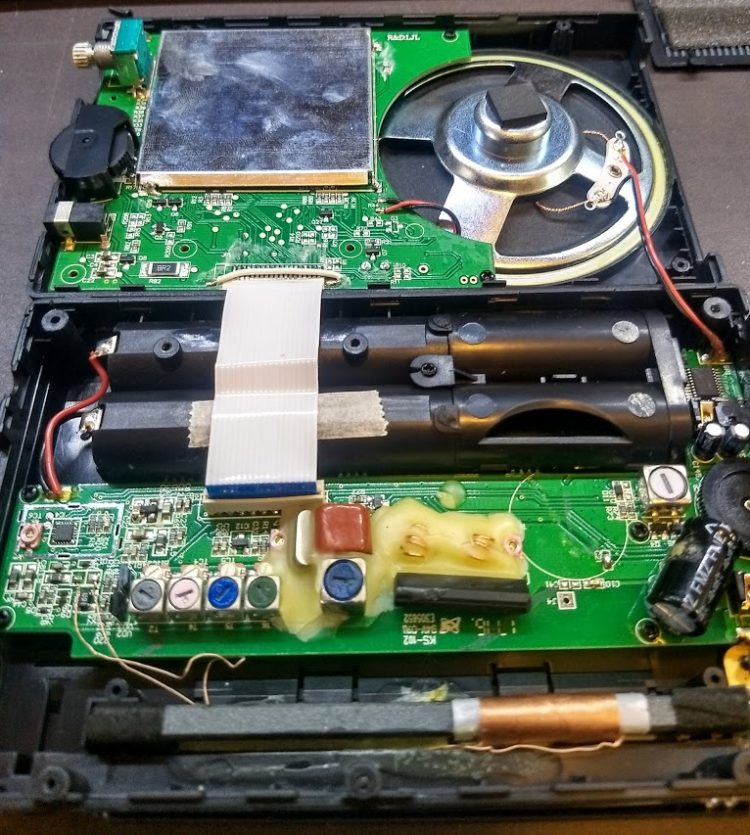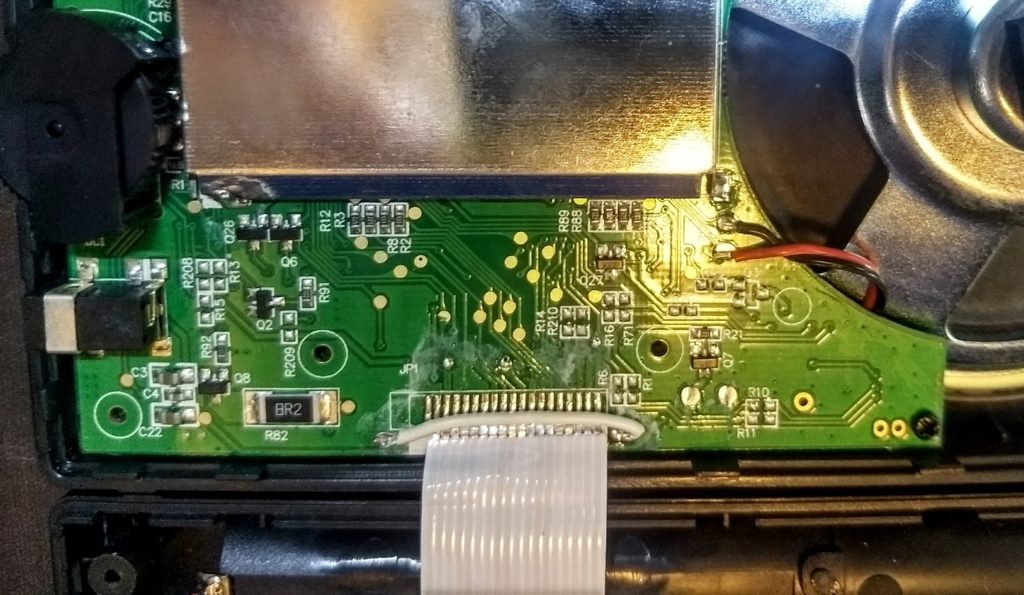 Last week, I posted a few photos of the new XHDATA D-808 and Digitech AR-1780–two of the hottest portable shortwave radios to hit the market in recent months.
Last week, I posted a few photos of the new XHDATA D-808 and Digitech AR-1780–two of the hottest portable shortwave radios to hit the market in recent months.
Several readers have requested “under the hood” photos of each radio, to compare internal designs. This morning, I had a few minutes to crack open each radio and take a few shots. Note that I didn’t pull off the circuit boards from the chassis or try to take a look behind shielding. I have yet to do proper performance comparison tests with these radios and didn’t want to accidentally compromise one (especially since the XHDATA D-808 is getting complicated to purchase here in the US).
Inside the XHDATA D-808
Opening the D-808 requires pulling off the encoder knob and removing a total of six small screws. Note that one of the screws is located in the battery compartment. Click photos to enlarge:
Inside the Digitech AR-1780
 Opening the AR-1780 requires pulling off the encoder knob (not an easy task on my unit) and removing a total of seven small screws. Note that two of the screws are located in the battery compartment. Click photos to enlarge:
Opening the AR-1780 requires pulling off the encoder knob (not an easy task on my unit) and removing a total of seven small screws. Note that two of the screws are located in the battery compartment. Click photos to enlarge:
























Judging by the free space for installing another SI4735, in the future it is planned to release a version of the receiver specifically for the US market. In this version, weather channels that exist only in America will also be added.
All these receivers (including ETON G3) are no different, even the numbering of the elements on the board is the same. One can safely use the scheme of one to repair another. http://www.radioscanner.ru/files/download/file19946/etonsatellitsch.pdf
I improved my D-808 receiver. I removed the magnetic antenna and made the input external on long and medium waves. On all bands the telescopic antenna works perfectly. https://cloud.mail.ru/public/8MpN/5KEdTSpDo
The flexible connecting loop quickly broke down, and I replaced it with a homemade classic cable:
https://cloud.mail.ru/public/5GmM/L4qXjn6HZ.
The circuit of the input circuits seemed not very successfu. It does a good job of reconciling with a telescopic antenna, but does not filter at all:
http://www.radioscanner.ru/uploader/2018/1_band.png
I tried to remake the input circuit, but there were difficulties with the exact matching of the tuning frequencies and everything was returned to the factory state.
But now I know how many turns in each coil:
https://cloud.mail.ru/public/GQrK/rAZpfMPLr
Thanks for sharing this information!
The receivers whose RF-circuits follow the same design http://www.radioscanner.ru/files/download/file19946/etonsatellitsch.pdf
are probably the following:
– Etón Satellit
– CCrane Skywave SSB
– Digitech AR-1780
– XHDATA D-808
It is confusing that the document number of the schematic contains “Eton G3”. But as Etón G3 was a traditional double conversion receiver without DSP, it cannot be the receiver shown in the schematic.
I don’t know who designed the RF-part of these receivers but
– Victor’s comment together with the schematic
– and that Etón Satellit was the first of these receivers in the market
seem to disprove the claim presented elsewhere in this blog that CCrane was the designer.
Well…for those bemoaning the lack of a jack for an external LW/MW antenna, it looks to these old eyes that there is ample space to neatly install a 3.5mm jack for that purpose. Once the jack is in place, wrap 5 or so turns of wire around the ferrite rod, and connect these leads to the jack. Now you have an inductively coupled input for the LW/MW antenna of your choice, and the inductance that the SiLabs chip wants to see at it’s input will remain unchanged.
Ok I’m a radio user not a builder but I’ve always been curious what is the yellow waxy looking substance supposed to do?
The gold/brassy coloured coils coils are (almost certainly) the FM tuning/osc coils. They’re not wound on a former so they’re easily de-tuned if they’re bumped, and the spacing / layout typically needs to be hand-adjusted at bit for final alignment anyway.
After that’s done they’re covered in wax or some similar sort of potting snot to keep them in place & prevent them moving & detuning the radio if dropped.
It definitely looks like the two use similar PCB architecture with minor changes due to the need to adapt each to fit into different size cases. If you look at the XHDATA 808 the casing looks identical to the
Tecsun PL 310. I’m guessing that Tecsun manufactures both but they are sold under license by
Digitech and XHDATA.
I see a section of circuit board with a chip, and components labelled C51, R10 & R6 in both sets of photos.
Peter Wilson
Las Palmas
Canary Islands
As the displays appear to be the same I concurr that the same chip could well be used. A weakness with the AR1780 is the external antenna jack. Mine broke the contacts inside the socket which isolated the telescopic whip. I managed to short out the internal switching.
As regards performance, I find that I can get some random oscillations near local FM stations which could be generated internally. It is also possible that they’re from an external source considering the noisy environment I am in. Aside from the noise the AR1780 does a good job of pulling in weaker signals. I have also received some strong signals via skip from Australia (I’m in Christchurch New Zealand)
My hunch is they are using the same chip set possibly minor difference is software and battery management hardware. It is difficult to tell the players apart without a scorecard. What I discovered is the AM and LW use the loop-stick antenna and SW FM AIR can be used with external antenna. Not to my liking, I wished the jack would turn off loop-stick antenna and activate the external antenna. so an external magnetic antenna can be used. I only paid $69.95 for it. I got what I paid for. No bargain These digitals disappoint me especially when a little more effort in design would result in a better set.
They look pretty much the same to me. I find it difficult to compare them on-screen, but they look very similar in most respects.
Compare the number and placement of RF transformers and other adjustable components on the main PCB in both radios.
Uh … yeah?
Like Andy, I’m not seeing any major differences at all. The front panel board is near-identical; the front end / RF board uses lightly different transformers, different style of variable caps associated with each, and apart from that the only real difference I’m seeing is a slightly different layout around the power connector and the generally poorer assembly quality of the Digitech.
And the latter was totally expected; what’s interesting about that is the XHDATA is actually _better_ assembled.
To be clear:
– In the XHDATA, I see 5 transformer cans – black, white, blue, green, light blue – with 5 associated trimmer caps (pink), two loose-wound coils, and another associated trimmer cap (pink)
– In the Digitech, I see 5 transformer cans – black white, blue, green, larger blue – with 5 associated trimmer caps (4 open-frame types, 1 small pink enclosed type), two loose-wound coils, and another associated trimmer cap (small ink enclosed type).
There’s minor board layout differences between the two to accomodate the different battery compartments & different make transformers / trimcaps, but apart from that they seem almost identical – the same basic parts, right down to the chips and passives, seem to be the same in each and, within the constraints of the different board shapes, in much the same place.
Thanks very much!
Even on superficial examination, clearly there are non-trivial differences in the hardware designs.
Hopes that the XHDATA D-808 would be an interchangeable-but-cheaper version of the AR-1780 seem less likely.
Excellent Thomas, thanks so much!